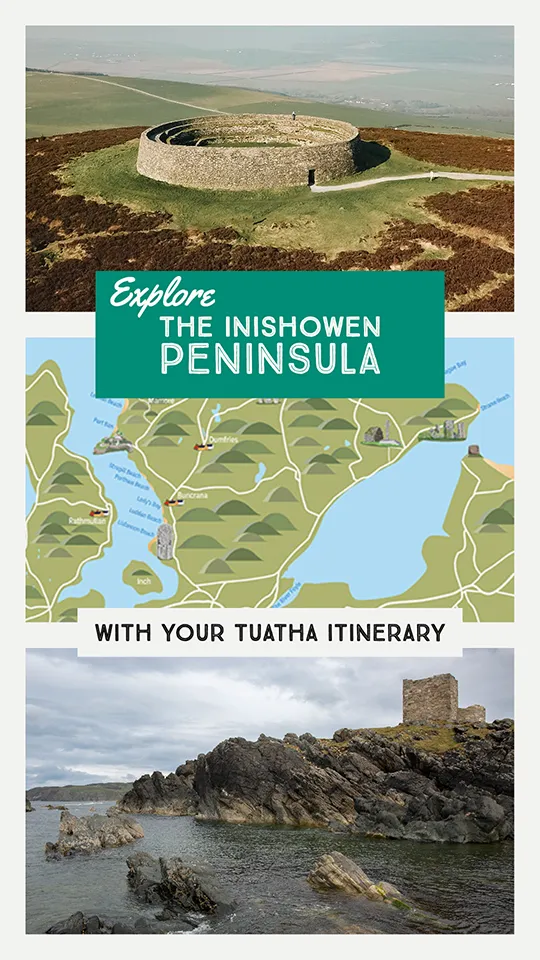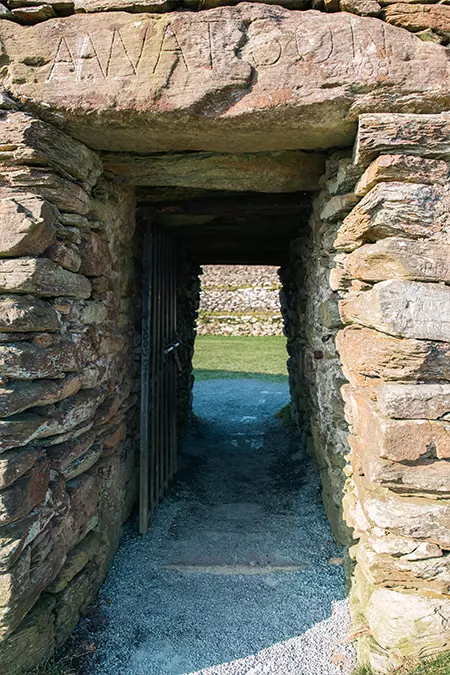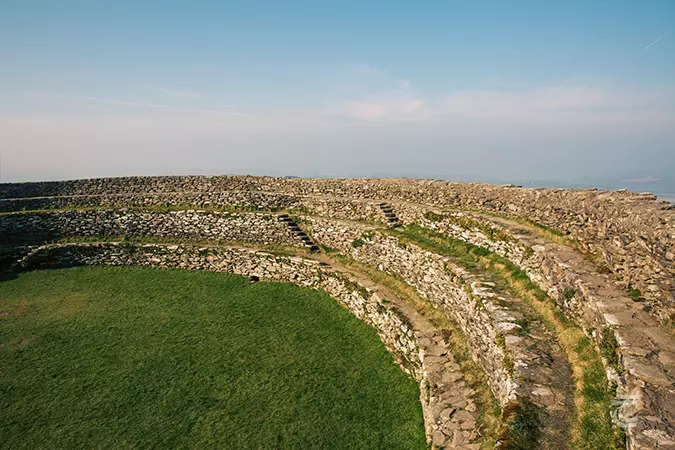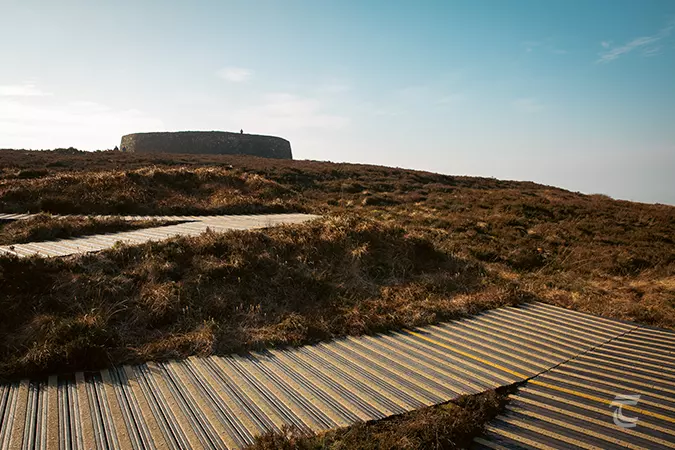Grianán of Aileach
The Grianán of Aileach, also known as An Grianán Fort, takes its name from ‘Grianán Ailigh’ which broadly translates as the ‘stony palace of the sun.’ Should you be lucky enough to arrive at sunrise or sunset on a clear day, it is clear that the fort is well named. The Grianán of Aileach is positioned on Greenan Mountain overlooking the valleys of the Foyle and Swilly rivers, affording extensive views over one of the most beautiful landscapes in Ireland. It is an impressive circular fort, with a diameter of 23m (76 feet), and with drystone walls that stand around 5m (16 feet) high. The top of the walls can be reached by a series of steps and terraces.
Beyond the fort, stone ramparts may provide evidence that this place has been regarded as important for millennia. The stone fort is surrounded by a series of three enclosing banks and ditches, though these are difficult to discern today. These may represent the remains of a hillfort dating to the late Bronze Age or early Iron Age. A holy well dedicated to St. Patrick can be found on the southern side of the hill, and further indication of ancient activity here can be found with the ‘tumulus’ recorded on the hill to the southeast of the drystone fort. This feature may represent the remains of a cairn or possibly a Neolithic passage tomb, given its elevated siting in the landscape.
Scroll down for more information about the history and folklore associated with The Grianán of Aileach.
For practical information about visiting this site Click Here
The Grianán of Aileach, also known as An Grianán Fort, takes its name from ‘Grianán Ailigh’ which broadly translates as the ‘stony palace of the sun.’ Should you be lucky enough to arrive at sunrise or sunset on a clear day, it is clear that the fort is well named. The Grianán of Aileach is positioned on Greenan Mountain overlooking the valleys of the Foyle and Swilly rivers, affording extensive views over one of the most beautiful landscapes in Ireland. It is an impressive circular fort, with a diameter of 23m (76 feet), and with drystone walls that stand around 5m (16 feet) high. The top of the walls can be reached by a series of steps and terraces.
Beyond the fort, stone ramparts may provide evidence that this place has been regarded as important for millennia. The stone fort is surrounded by a series of three enclosing banks and ditches, though these are difficult to discern today. These may represent the remains of a hillfort dating to the late Bronze Age or early Iron Age. A holy well dedicated to St. Patrick can be found on the southern side of the hill, and further indication of ancient activity here can be found with the ‘tumulus’ recorded on the hill to the southeast of the drystone fort. This feature may represent the remains of a cairn or possibly a Neolithic passage tomb, given its elevated siting in the landscape.
Scroll down for more information about the history and folklore associated with The Grianán of Aileach.
For practical information about visiting this site Click Here
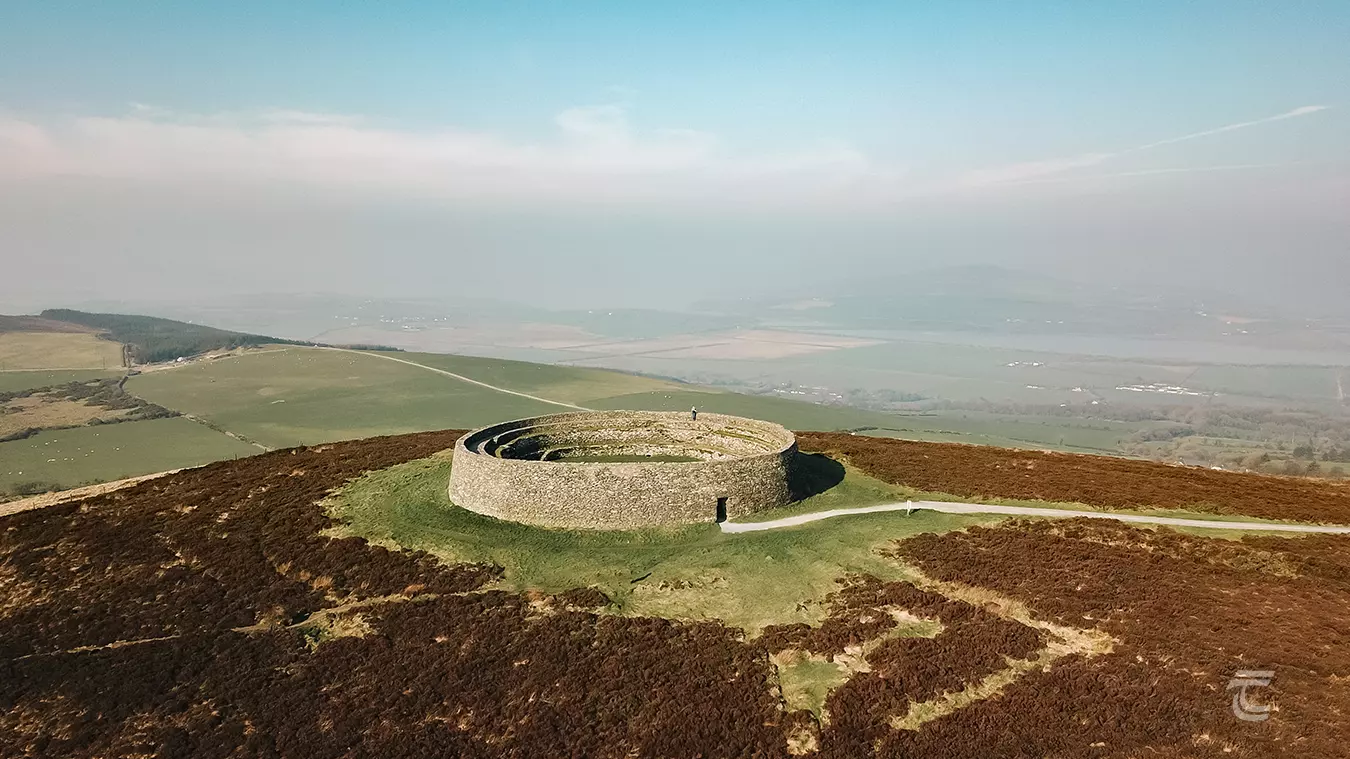
An aerial view of Grianán of Aileach • Donegal
The History of the Grianán of Aileach / An Grianán Fort
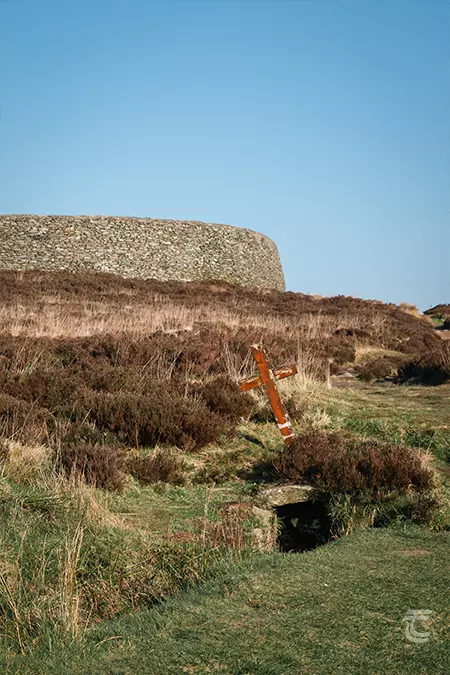
The small holy well below An Grianán • Donegal
The fort was once the ancient royal seat of the Cenél nEógain, a branch of the Northern Uí Néill, one of the most powerful and influential of Ireland’s early medieval dynasties. An Grianán appears in the Dindshenchas, a set of early medieval poems about the origins and traditions of places. Some of this work can be attributed to Flann Mainistrech of Monasterboice who died in 1056. The Dindshenchas refers to the Grianán of Aileach as a ‘lofty castle’ and ‘honoured above hills like the silent Hill of Tara’.
Aileach Frigrenn, faithche na ríg rígda in domain
dún cos’ roichdis róit fo gregaib tre chóic clodaib.
Aileach Frigrenn, green-sward of the world’s royal kings,
fortress to which led roads horse-trodden, through five ramparts.
One of the famous kings of the Cenél nEógain was the High King Niall Glúndub. A powerful figure in 10th century Ireland and a noted warrior, he became embroiled in wars against the Viking Ívarr Dynasty, or the Uí Ímair, who had arrived in Waterford and Southern Leinster in 917. After a number of campaigns, Niall Glúndub and the Uí Néill were comprehensively defeated near Dublin in 919. This was a disastrous defeat not only for the Uí Néill, but also for their allies as a number of Irish kings were killed. A tradition relates how Niall Glúndub was buried in the cairn on the summit of Tribadden Mountain, though this is likely to be the result of a conflation of the site of the battle at the ‘Fords of Cill Mosamhog’ with the modern name Kilmashogue.
It is thought that the Grianán of Aileach was the main royal residence of the Cenél nEógain until around the late 930s, when they moved to Tullaghoge in Tyrone. The Annals of the Four Masters record how the true end of the fort came to a shocking conclusion in the year 1101, when the King of Munster Muirchertach Ua Briain, demolished the fort. This was in retaliation for an outrageous event in 1088, when the Cenél nEógain and Uí Néill defeated the men of Munster and marched to the Ua Briain royal site at Kincora, and forced them to cut their hazel trees and to carry the timber all the way back to Ulster to use as wood to roof a hall in the Grianán of Aileach. In revenge, when Muirchertach Ua Briain conquered the armies of the Uí Néill, he made the defeated warriors carry stones from the fort back to Munster.
The Annals of the Four Masters recounts:

The small holy well below An Grianán • Donegal
Ní chuala coinnmheadh neimhir,
Ciat chuala coinnmheadh muirir
Gar coinnmheadh cloche Oiligh,
For ghroighibh flatha Fuinidh
I never heard of the billeting of grit stones,
Though I heard of the billeting of companies
Until the stones of Oileach were billeted
On the horses of the King of the West
For more on the history of this iconic site and the Cenél nEógain I recommend The Kings of Aileach and the Vikings, AD 800–1060 by Darren McGettigan.
The Grianán of Aileach was visited by John O’Donovan and George Petrie during the Ordnance Survey in the 1830s, though by the later 19th century the fort was deemed to be in a precarious condition. Extensive repair and restoration was carried out by Walter Bernard between 1874–1878 and the appearance of the stone fort today is largely due to that work.
Left: the entrance to the fort • Upper right: the stone rampart • Lower right: the winding ramp up to the fort
Top: the entrance to the fort • Middle: the stone rampart • Bottom: the winding ramp up to the fort
Folklore, Myths and Legends of An Grianán Fort
The Grianán of Aileach is associated with a rich tapestry of mythology, tales and legends. One legend tells of Dagda, the king of the godly Tuatha de Dannán. His son, Aodh, was killed by a man named Coirgean, in a fit of jealousy. Instead of killing the perpetrator on the spot, Dagda placed a géis, [an unbreakable oath], on Coirgean which meant he was compelled to carry Aodh’s body until he found a flag stone big enough to cover the slaughtered god. Coirgean carried Aodh for miles, until he climbed this hill and found the right stone. He buried Aodh beneath it, and then promptly dropped dead of exhaustion. To mark the burial place of his son, Dagda had a palace constructed on the hilltop, and held fairs in celebration of Aodh’s life. From the Dindshenchas:
Cnoc arar-chotail in Dagda, dearg a scotha,
Imda a thige, terc a chrecha, cert a cloche
Hill where the Dagda slept, red are its flowers,
many its houses, few its plunderings, correct its stones.
A tale from the National Folklore Collection tells of a man who was on the run from English soldiers. He sought to escape by climbing the steep slopes of the Grianán of Aileach, but he saw the soldiers had the hill surrounded and that he was trapped. In desperation, he looked around for a place to hide and noticed a small doorway which he had never seen before. The door was ajar and a passageway behind it appeared to lead into the side of the hill. With the soldiers closing in, the man had no choice but to venture down the passageway. He closed the door behind him, and outside he could hear the confused soldiers searching for him, then angrily leaving the hill empty-handed. But rather than taking a risk by going back outside, he chose to follow a dim light and venture deeper down the dark passageway.
As he walked along the passage the light grew steadily stronger, until he came out into a large hall where he saw a king sleeping on a chair, flanked by his court and bards, and with thousands of warriors all slumbering around him. He implored the slumbering host to rise up and to attack the English. At the sound of his voice, the strange king opened his eyes and said “the time has not yet come” and went to sleep again. It is said they still slumber under the hill, until a day when a woman lights four fires, one north, one south, one east and one west and the final one on Mount Errigal. Then she must sound a great horn on Aileach. As the note ends seven doors will open in the ground and the host will charge from the side of the hill, where they will race around the country to set Ireland free.
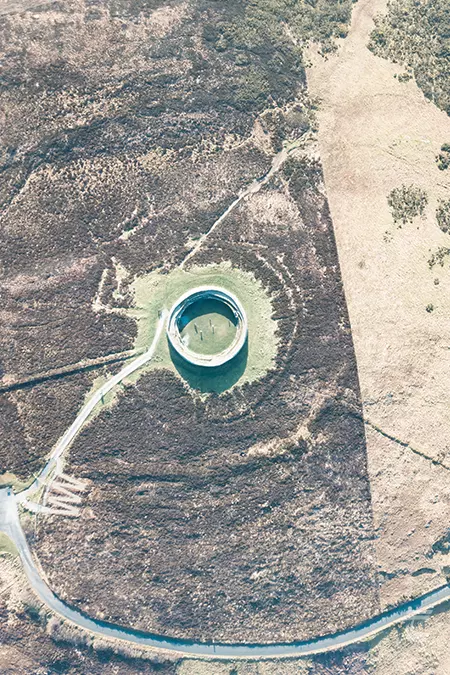
Aerial view of An Grianán • Donegal
